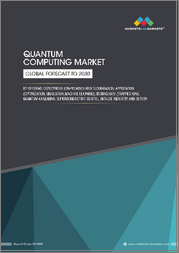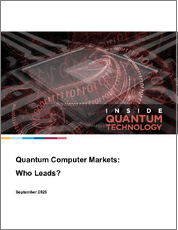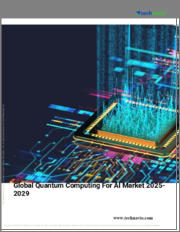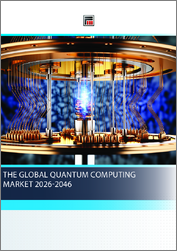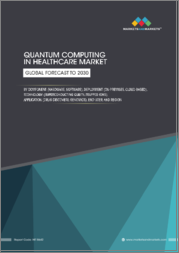
|
시장보고서
상품코드
1620793
세계의 양자 전쟁 시장 : 부품별, 양자 컴퓨터 유형별, 기술 분류별, 용도별 예측(2025-2030년)Quantum Warfare Market by Component (Antenna, Clock, Magnetometer), Quantum Computer Type (Analog Quantum Computer, Digital Quantum Computer, Quantum Simulator), Technique Taxonomy, Application - Global Forecast 2025-2030 |
||||||
양자전쟁시장은 2023년 14억 6,000만 달러로 평가되었고, 2024년 16억 9,000만 달러에 이를 것으로 예측되며, CAGR 16.10%로 성장하며 2030년에는 41억 7,000만 달러가 될 것으로 예측됩니다.
양자전쟁은 양자기술을 전략적으로 활용하고 방위·안보활동으로 우위에 서는 것을 포함하고 있습니다. 안전한 통신 채널, 선진적 인텔리전스 능력을 개발합니다. 세계의 위협이 복잡해지고, 각국이 기술 혁신을 통해 전략적 우위성을 유지할 필요성이 높아지고 있기 때문에 양자 전쟁이 필요합니다. 주요 용도에는 해킹에 강한 안전한 양자암호 통신 시스템, 스텔스 항공기를 감지할 수 있는 양자 강화 레이더 시스템, 기존의 암호화 방법을 깨뜨릴 수 있는 강력한 양자 컴퓨터 등이 최종 용도는 국가 안보의 틀을 강화하고 세계의 분쟁으로 우위에 서는 것을 목표로 하는 군 및 방위 부문에 걸칩니다.
| 주요 시장 통계 | |
|---|---|
| 기준년 (2023년) | 14억 6,000만 달러 |
| 추정년 (2024년) | 16억 9,000만 달러 |
| 예측년(2030년) | 41억 7,000만 달러 |
| CAGR(%) | 16.10% |
시장 인사이트에 따르면 양자 전쟁 시장의 성장은 방위 관련 연구 개발에 대한 많은 투자와 정부와 민간 기업 간의 협력에 의해 영향을 받고 있습니다. 긴급성이 시장 수요를 뒷받침하고 있습니다. 양자암호화 솔루션 개발 및 양자 기반 정보, 모니터링, 정찰(ISR) 시스템 개발에 있습니다.
그러나 시장은 기술의 복잡성, 양자 인프라 개척에 따른 고비용, 양자 기술의 국제적 보급에 관한 규제상의 과제 등의 제약에 직면하고 있습니다. 확장성 및 방어 시나리오에서 실용적인 구현에 의문이 있습니다.
확장 가능한 양자 네트워크 개발, 광자 기반 양자 통신 개발, 적응성 있는 내양자암호화 표준 개발 등 혁신이 필요한 부문입니다. 솔루션의 지적 재산권을 확보하면 비즈니스 성장을 가속할 수 있습니다. 양자전쟁시장은 역동적이며 급속한 기술진보가 특징입니다. 투자를 통해 혁신 생태계를 육성함으로써 경쟁 우위를 확보할 수 있습니다.
시장 역학: 급속히 진화하는 양자전쟁시장의 주요 시장 인사이트 공개
양자전쟁시장은 수요 및 공급의 역동적인 상호작용에 의해 변모를 이루고 있습니다. 새로운 비즈니스 기회를 얻기 위해 준비할 수 있습니다. 이러한 동향을 종합적으로 파악함으로써 기업은 정치적, 지리적, 기술적, 사회적, 경제적인 영역에 걸친 다양한 리스크를 경감할 수 있음과 동시에, 소비자 행동과 그것이 제조 비용이나 구매 동향에 미치는 영향을 보다 명확하게 이해할 수 있습니다.
- 시장 성장 촉진요인
- 방위 및 군사 산업에 있어서의 양자 복지의 조기 도입
- 선진적 국가 안보와 방어 메커니즘의 요구 증가
- 혁신을 촉진하기 위한 지역 정부의 시책과 다액의 자금 원조가 시장을 세계에 육성
- 시장 성장 억제요인
- 고정밀도를 필요로 하는 숙련 노동자의 부족
- 시장 기회
- 방위 통신에 있어서의 기술의 진보
- 양자 컴퓨팅, 양자 감지, 양자암호, 양자 통신에 대한 투자 증가
- 시장의 과제
- 양자전쟁과 관련된 운영상의 문제
Porter's Five Force : 양자 전쟁 시장을 탐색하는 전략 도구
Porter's Five Force Framework는 양자 전쟁 시장 경쟁 구도를 이해하는 중요한 도구입니다. 기업이 시장 내 세력도를 평가하고 신규 사업의 수익성을 판단하는 데 도움이 됩니다. 피할 수 있으며 더 강인한 시장에서 포지셔닝을 보장 할 수 있습니다.
PESTLE 분석 : 양자 전쟁 시장에서 외부로부터의 영향 파악
외부 거시 환경 요인은 양자 전쟁 시장의 성과 역학을 형성하는데 매우 중요한 역할을합니다. 탐색하는 데 필요한 정보를 제공합니다. PESTLE 요인을 조사함으로써 기업은 잠재적인 위험과 기회를 더 잘 이해할 수 있습니다. 적극적인 의사 결정을 할 준비가되어 있습니다.
시장 점유율 분석 : 양자 전쟁 시장에서 경쟁 구도 파악
양자 전쟁 시장의 상세한 시장 점유율 분석을 통해 공급업체의 성과를 종합적으로 평가할 수 있습니다. 이 분석은 시장의 집중, 부문화 및 통합 동향을 밝혀내고, 벤더는 경쟁이 격화되는 가운데 자신의 지위를 높이는 전략적 의사결정을 하기 위해 필요한 지견을 얻을 수 있습니다.
FPNV 포지셔닝 매트릭스: 양자 전쟁 시장에서 공급업체의 성능 평가
FPNV 포지셔닝 매트릭스는 양자 전쟁 시장에서 벤더를 평가하는 중요한 도구입니다. 기본 결정을 내릴 수 있습니다. 네 가지 사분면을 통해 벤더를 명확하고 정확하게 분할하고 전략 목표에 가장 적합한 파트너 및 솔루션을 파악할 수 있습니다.
전략 분석 및 추천: 양자 전쟁 시장에서 성공을 위한 길을 그리기
양자 전쟁 시장의 전략분석은 세계 시장에서의 프레즌스 강화를 목표로 하는 기업에 필수적입니다. 이 접근법을 통해 경쟁 구도에서 과제를 극복하고 새로운 비즈니스 기회를 활용하여 장기적인 성공을 거둘 수 있는 체제를 마련할 수 있습니다.
이 보고서는 주요 관심 분야를 다루는 시장에 대한 종합적인 분석을 제공합니다.
1. 시장 침투: 현재 시장 환경의 상세한 검토, 주요 기업의 광범위한 데이터, 시장 도달범위 및 전반적인 영향력을 평가합니다.
2. 시장 개척도: 신흥 시장의 성장 기회를 파악하고, 기존 부문에서의 확장 가능성을 평가하며, 미래 성장을 위한 전략적 로드맵을 설명합니다.
3. 시장 다양화: 최근 제품 출시, 미개척 지역, 산업의 주요 진보, 시장을 형성하는 전략적 투자를 분석합니다.
4. 경쟁 평가 및 정보 : 경쟁 구도를 철저히 분석하여 시장 점유율, 사업 전략, 제품 포트폴리오, 인증, 규제 당국 승인, 특허 동향, 주요 기업의 기술 진보 등을 검증합니다.
5. 제품 개발 및 혁신 : 미래 시장 성장을 가속할 것으로 예상되는 최첨단 기술, R&D 활동, 제품 혁신을 강조합니다.
또한 이해관계자가 충분한 정보를 얻고 의사결정을 할 수 있도록 중요한 질문에도 대답하고 있습니다.
1. 현재 시장 규모와 향후 성장 예측은?
2. 최고의 투자 기회를 제공하는 제품, 지역은 어디입니까?
3. 시장을 형성하는 주요 기술 동향과 규제의 영향은?
4. 주요 벤더의 시장 점유율과 경쟁 포지션은?
5. 벤더 시장 진입·철수 전략의 원동력이 되는 수익원과 전략적 기회는 무엇인가?
목차
제1장 서문
제2장 조사 방법
제3장 주요 요약
제4장 시장 개요
제5장 시장 인사이트
- 시장 역학
- 성장 촉진요인
- 방위 및 군사 산업에 있어서의 양자 복지의 조기 도입
- 국가 안보 및 방어 메커니즘의 고도화 필요성 증가
- 지역 정부의 시책과 다액의 자금 제공에 의해 세계적으로 혁신을 촉진해 시장을 육성한다
- 억제요인
- 높은 정밀도가 요구되는 숙련 노동력의 부족
- 기회
- 방위 통신에 있어서의 기술의 진보
- 양자 컴퓨팅, 양자 감지, 양자암호, 양자 통신에 대한 투자 증가
- 과제
- 양자전쟁과 관련된 운영상의 문제
- 성장 촉진요인
- 시장 세분화 분석
- 부품: 양자 전쟁의 감도와 스텔스 기능이 향상된 안테나의 필요성
- 용도: 육상전에서의 물류 관리, 통신 보안, 부대 방위 기술에의 양자 컴퓨팅의 통합
- Porter's Five Forces 분석
- PESTEL 분석
- 정치
- 경제
- 사회
- 기술
- 법률
- 환경
제6장 양자 전쟁 시장 : 부품별
- 소개
- 안테나
- 시계
- 자력계
- 레이더
- 센서
제7장 양자 전쟁 시장 : 양자 컴퓨터 유형별
- 소개
- 아날로그 양자 컴퓨터
- 디지털 양자 컴퓨터
- 양자 시뮬레이터
제8장 양자 전쟁 시장 : 기술 분류별
- 소개
- 양자통신과 암호
- 양자 컴퓨팅과 시뮬레이션
- 양자 감지 및 측정
제9장 양자 전쟁 시장 : 용도별
- 소개
- 공군
- 육군
- 해군
제10장 아메리카 양자 전쟁 시장
- 소개
- 아르헨티나
- 브라질
- 캐나다
- 멕시코
- 미국
제11장 아시아태평양 양자 전쟁 시장
- 소개
- 호주
- 중국
- 인도
- 인도네시아
- 일본
- 말레이시아
- 필리핀
- 싱가포르
- 한국
- 대만
- 태국
- 베트남
제12장 유럽·중동 및 아프리카 양자 전쟁 시장
- 소개
- 덴마크
- 이집트
- 핀란드
- 프랑스
- 독일
- 이스라엘
- 이탈리아
- 네덜란드
- 나이지리아
- 노르웨이
- 폴란드
- 카타르
- 러시아
- 사우디아라비아
- 남아프리카
- 스페인
- 스웨덴
- 스위스
- 터키
- 아랍에미리트(UAE)
- 영국
제13장 경쟁 구도
- 시장 점유율 분석, 2023년
- FPNV 포지셔닝 매트릭스, 2023년
- 경쟁 시나리오 분석
- IonQ, 미국 공군 조사와 새롭게 2,550만 달러의 양자 계약을 체결
- QuSecure, PQC의 미국군 계약을 획득
- QuSecure, 포스트 양자 사이버 보안 솔루션으로 미국 육군과 계약을 체결
- 전략 분석과 제안
기업 목록
- Airbus SE
- BAE Systems PLC
- D-Wave Systems
- Google LLC by Alphabet inc.
- Honeywell International Inc.
- ID Quantique SA
- Infleqtion
- International Business Machines Corporation
- ISARA Corporation
- L3Harris Technologies, Inc.
- Leidos, Inc.
- Microsoft Corporation
- Q-CTRL Pty Ltd.
- Quantum Computing
- Quantum Research International, Inc.
- QuSecure, Inc.
- Rigetti & Co, LLC
- Thales Group
The Quantum Warfare Market was valued at USD 1.46 billion in 2023, expected to reach USD 1.69 billion in 2024, and is projected to grow at a CAGR of 16.10%, to USD 4.17 billion by 2030.
Quantum warfare encompasses the strategic use of quantum technologies to achieve superiority in defense and security operations. It involves harnessing quantum computing, quantum communication, and quantum sensing to develop advanced weaponry, secure communication channels, and enhanced intelligence capabilities. The necessity for quantum warfare is underscored by the growing complexity of global threats and the need for nations to maintain a strategic edge through technological innovation. Key applications include secure quantum-encrypted communication systems resistant to hacking, quantum-enhanced radar systems that can detect stealth aircraft, and powerful quantum computers capable of breaking traditional encryption methods. The end-use scope spans military and defense sectors aiming to fortify national security frameworks and achieve dominance in global conflicts.
| KEY MARKET STATISTICS | |
|---|---|
| Base Year [2023] | USD 1.46 billion |
| Estimated Year [2024] | USD 1.69 billion |
| Forecast Year [2030] | USD 4.17 billion |
| CAGR (%) | 16.10% |
Market insights reveal that the growth of the quantum warfare market is influenced by substantial investment in defense-related research and development, coupled with collaborations between governments and private sector entities. The increasing geopolitical tensions and the urgency to counter emerging threats propel market demand. Key opportunities lie in advancing quantum cryptography solutions and developing quantum-based intelligence, surveillance, and reconnaissance (ISR) systems. Companies can capitalize on these opportunities by forming strategic alliances with defense agencies and investing in cutting-edge quantum research initiatives.
However, the market faces limitations, including technological complexities, high costs associated with quantum infrastructure development, and regulatory challenges related to the international proliferation of quantum technologies. Additionally, quantum technologies' infancy poses questions around scalability and practical implementation in defense scenarios.
Areas ripe for innovation include developing scalable quantum networks, advancing photon-based quantum communication, and creating adaptive quantum-resistant encryption standards. Engaging with academic institutions for pioneering research and securing intellectual property rights on novel quantum solutions could drive business growth. The quantum warfare market is dynamic and characterized by rapid technological advancements. Companies can gain a competitive edge by staying ahead of emerging trends, anticipating future regulatory landscapes, and fostering an ecosystem of innovation through cross-disciplinary collaborations and targeted investment in key tech domains.
Market Dynamics: Unveiling Key Market Insights in the Rapidly Evolving Quantum Warfare Market
The Quantum Warfare Market is undergoing transformative changes driven by a dynamic interplay of supply and demand factors. Understanding these evolving market dynamics prepares business organizations to make informed investment decisions, refine strategic decisions, and seize new opportunities. By gaining a comprehensive view of these trends, business organizations can mitigate various risks across political, geographic, technical, social, and economic domains while also gaining a clearer understanding of consumer behavior and its impact on manufacturing costs and purchasing trends.
- Market Drivers
- Early adoption of quantum welfare in defense and military industry
- Rising need of advance national security and defense mechanisms
- Regional government policies and substantial funding to foster innovation fostering marketplace globally
- Market Restraints
- Lack of skilled workforce with need for high accuracy
- Market Opportunities
- Technological advancements in the defense communication
- Rising investments in quantum computing, quantum sensing, quantum cryptography, and quantum communication
- Market Challenges
- Operational issues of associated with quantum warfare
Porter's Five Forces: A Strategic Tool for Navigating the Quantum Warfare Market
Porter's five forces framework is a critical tool for understanding the competitive landscape of the Quantum Warfare Market. It offers business organizations with a clear methodology for evaluating their competitive positioning and exploring strategic opportunities. This framework helps businesses assess the power dynamics within the market and determine the profitability of new ventures. With these insights, business organizations can leverage their strengths, address weaknesses, and avoid potential challenges, ensuring a more resilient market positioning.
PESTLE Analysis: Navigating External Influences in the Quantum Warfare Market
External macro-environmental factors play a pivotal role in shaping the performance dynamics of the Quantum Warfare Market. Political, Economic, Social, Technological, Legal, and Environmental factors analysis provides the necessary information to navigate these influences. By examining PESTLE factors, businesses can better understand potential risks and opportunities. This analysis enables business organizations to anticipate changes in regulations, consumer preferences, and economic trends, ensuring they are prepared to make proactive, forward-thinking decisions.
Market Share Analysis: Understanding the Competitive Landscape in the Quantum Warfare Market
A detailed market share analysis in the Quantum Warfare Market provides a comprehensive assessment of vendors' performance. Companies can identify their competitive positioning by comparing key metrics, including revenue, customer base, and growth rates. This analysis highlights market concentration, fragmentation, and trends in consolidation, offering vendors the insights required to make strategic decisions that enhance their position in an increasingly competitive landscape.
FPNV Positioning Matrix: Evaluating Vendors' Performance in the Quantum Warfare Market
The Forefront, Pathfinder, Niche, Vital (FPNV) Positioning Matrix is a critical tool for evaluating vendors within the Quantum Warfare Market. This matrix enables business organizations to make well-informed decisions that align with their goals by assessing vendors based on their business strategy and product satisfaction. The four quadrants provide a clear and precise segmentation of vendors, helping users identify the right partners and solutions that best fit their strategic objectives.
Strategy Analysis & Recommendation: Charting a Path to Success in the Quantum Warfare Market
A strategic analysis of the Quantum Warfare Market is essential for businesses looking to strengthen their global market presence. By reviewing key resources, capabilities, and performance indicators, business organizations can identify growth opportunities and work toward improvement. This approach helps businesses navigate challenges in the competitive landscape and ensures they are well-positioned to capitalize on newer opportunities and drive long-term success.
Key Company Profiles
The report delves into recent significant developments in the Quantum Warfare Market, highlighting leading vendors and their innovative profiles. These include Airbus SE, BAE Systems PLC, D-Wave Systems, Google LLC by Alphabet inc., Honeywell International Inc., ID Quantique SA, Infleqtion, International Business Machines Corporation, ISARA Corporation, L3Harris Technologies, Inc., Leidos, Inc., Microsoft Corporation, Q-CTRL Pty Ltd., Quantum Computing, Quantum Research International, Inc., QuSecure, Inc., Rigetti & Co, LLC, and Thales Group.
Market Segmentation & Coverage
This research report categorizes the Quantum Warfare Market to forecast the revenues and analyze trends in each of the following sub-markets:
- Based on Component, market is studied across Antenna, Clock, Magnetometer, Radar, and Sensor.
- Based on Quantum Computer Type, market is studied across Analog Quantum Computer, Digital Quantum Computer, and Quantum Simulator.
- Based on Technique Taxonomy, market is studied across Quantum Communication & Cryptography, Quantum Computing & Simulations, and Quantum Sensing & Metrology.
- Based on Application, market is studied across Airborne, Land, and Naval.
- Based on Region, market is studied across Americas, Asia-Pacific, and Europe, Middle East & Africa. The Americas is further studied across Argentina, Brazil, Canada, Mexico, and United States. The United States is further studied across California, Florida, Illinois, New York, Ohio, Pennsylvania, and Texas. The Asia-Pacific is further studied across Australia, China, India, Indonesia, Japan, Malaysia, Philippines, Singapore, South Korea, Taiwan, Thailand, and Vietnam. The Europe, Middle East & Africa is further studied across Denmark, Egypt, Finland, France, Germany, Israel, Italy, Netherlands, Nigeria, Norway, Poland, Qatar, Russia, Saudi Arabia, South Africa, Spain, Sweden, Switzerland, Turkey, United Arab Emirates, and United Kingdom.
The report offers a comprehensive analysis of the market, covering key focus areas:
1. Market Penetration: A detailed review of the current market environment, including extensive data from top industry players, evaluating their market reach and overall influence.
2. Market Development: Identifies growth opportunities in emerging markets and assesses expansion potential in established sectors, providing a strategic roadmap for future growth.
3. Market Diversification: Analyzes recent product launches, untapped geographic regions, major industry advancements, and strategic investments reshaping the market.
4. Competitive Assessment & Intelligence: Provides a thorough analysis of the competitive landscape, examining market share, business strategies, product portfolios, certifications, regulatory approvals, patent trends, and technological advancements of key players.
5. Product Development & Innovation: Highlights cutting-edge technologies, R&D activities, and product innovations expected to drive future market growth.
The report also answers critical questions to aid stakeholders in making informed decisions:
1. What is the current market size, and what is the forecasted growth?
2. Which products, segments, and regions offer the best investment opportunities?
3. What are the key technology trends and regulatory influences shaping the market?
4. How do leading vendors rank in terms of market share and competitive positioning?
5. What revenue sources and strategic opportunities drive vendors' market entry or exit strategies?
Table of Contents
1. Preface
- 1.1. Objectives of the Study
- 1.2. Market Segmentation & Coverage
- 1.3. Years Considered for the Study
- 1.4. Currency & Pricing
- 1.5. Language
- 1.6. Stakeholders
2. Research Methodology
- 2.1. Define: Research Objective
- 2.2. Determine: Research Design
- 2.3. Prepare: Research Instrument
- 2.4. Collect: Data Source
- 2.5. Analyze: Data Interpretation
- 2.6. Formulate: Data Verification
- 2.7. Publish: Research Report
- 2.8. Repeat: Report Update
3. Executive Summary
4. Market Overview
5. Market Insights
- 5.1. Market Dynamics
- 5.1.1. Drivers
- 5.1.1.1. Early adoption of quantum welfare in defense and military industry
- 5.1.1.2. Rising need of advance national security and defense mechanisms
- 5.1.1.3. Regional government policies and substantial funding to foster innovation fostering marketplace globally
- 5.1.2. Restraints
- 5.1.2.1. Lack of skilled workforce with need for high accuracy
- 5.1.3. Opportunities
- 5.1.3.1. Technological advancements in the defense communication
- 5.1.3.2. Rising investments in quantum computing, quantum sensing, quantum cryptography, and quantum communication
- 5.1.4. Challenges
- 5.1.4.1. Operational issues of associated with quantum warfare
- 5.1.1. Drivers
- 5.2. Market Segmentation Analysis
- 5.2.1. Component: Need for antennas with improved sensitivity and stealth capabilities for quantum warfare
- 5.2.2. Application: Integration of quantum computing in land warfare for logistics management, communication security, and force protection technologies
- 5.3. Porter's Five Forces Analysis
- 5.3.1. Threat of New Entrants
- 5.3.2. Threat of Substitutes
- 5.3.3. Bargaining Power of Customers
- 5.3.4. Bargaining Power of Suppliers
- 5.3.5. Industry Rivalry
- 5.4. PESTLE Analysis
- 5.4.1. Political
- 5.4.2. Economic
- 5.4.3. Social
- 5.4.4. Technological
- 5.4.5. Legal
- 5.4.6. Environmental
6. Quantum Warfare Market, by Component
- 6.1. Introduction
- 6.2. Antenna
- 6.3. Clock
- 6.4. Magnetometer
- 6.5. Radar
- 6.6. Sensor
7. Quantum Warfare Market, by Quantum Computer Type
- 7.1. Introduction
- 7.2. Analog Quantum Computer
- 7.3. Digital Quantum Computer
- 7.4. Quantum Simulator
8. Quantum Warfare Market, by Technique Taxonomy
- 8.1. Introduction
- 8.2. Quantum Communication & Cryptography
- 8.3. Quantum Computing & Simulations
- 8.4. Quantum Sensing & Metrology
9. Quantum Warfare Market, by Application
- 9.1. Introduction
- 9.2. Airborne
- 9.3. Land
- 9.4. Naval
10. Americas Quantum Warfare Market
- 10.1. Introduction
- 10.2. Argentina
- 10.3. Brazil
- 10.4. Canada
- 10.5. Mexico
- 10.6. United States
11. Asia-Pacific Quantum Warfare Market
- 11.1. Introduction
- 11.2. Australia
- 11.3. China
- 11.4. India
- 11.5. Indonesia
- 11.6. Japan
- 11.7. Malaysia
- 11.8. Philippines
- 11.9. Singapore
- 11.10. South Korea
- 11.11. Taiwan
- 11.12. Thailand
- 11.13. Vietnam
12. Europe, Middle East & Africa Quantum Warfare Market
- 12.1. Introduction
- 12.2. Denmark
- 12.3. Egypt
- 12.4. Finland
- 12.5. France
- 12.6. Germany
- 12.7. Israel
- 12.8. Italy
- 12.9. Netherlands
- 12.10. Nigeria
- 12.11. Norway
- 12.12. Poland
- 12.13. Qatar
- 12.14. Russia
- 12.15. Saudi Arabia
- 12.16. South Africa
- 12.17. Spain
- 12.18. Sweden
- 12.19. Switzerland
- 12.20. Turkey
- 12.21. United Arab Emirates
- 12.22. United Kingdom
13. Competitive Landscape
- 13.1. Market Share Analysis, 2023
- 13.2. FPNV Positioning Matrix, 2023
- 13.3. Competitive Scenario Analysis
- 13.3.1. IonQ Announces New USD 25.5 Million Quantum Deal with United States Air Force Research Lab
- 13.3.2. QuSecure Earns U.S. Army Contract for PQC
- 13.3.3. QuSecure Awarded U.S. Army Contract for Post-Quantum Cybersecurity Solutions
- 13.4. Strategy Analysis & Recommendation
Companies Mentioned
- 1. Airbus SE
- 2. BAE Systems PLC
- 3. D-Wave Systems
- 4. Google LLC by Alphabet inc.
- 5. Honeywell International Inc.
- 6. ID Quantique SA
- 7. Infleqtion
- 8. International Business Machines Corporation
- 9. ISARA Corporation
- 10. L3Harris Technologies, Inc.
- 11. Leidos, Inc.
- 12. Microsoft Corporation
- 13. Q-CTRL Pty Ltd.
- 14. Quantum Computing
- 15. Quantum Research International, Inc.
- 16. QuSecure, Inc.
- 17. Rigetti & Co, LLC
- 18. Thales Group






